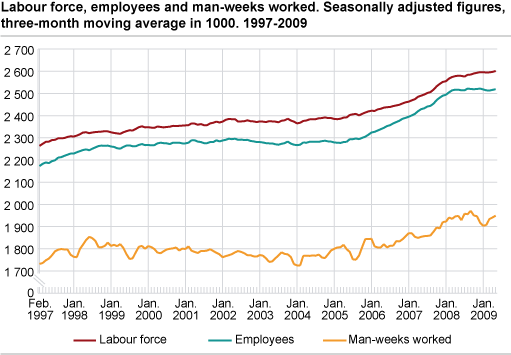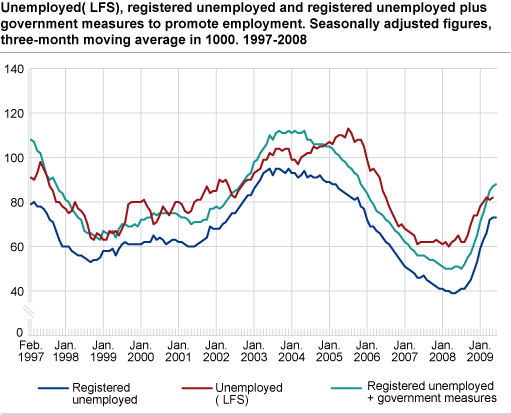Content
Published:
This is an archived release.
Fewer young people employed
From the second quarter of 2008 to the second quarter of 2009 there was a reduction of 10 000 people in employment in the age group 15 - 24. More people stayed in education.
Seasonally-adjusted figures: Stable labour marketBoth employment and unemployment remained at the same level in the second quarter of 2009 as in the first quarter of 2009. The unemployment rate was 3.1 percent of the labour force in the second quarter of 2009. Adjustments for seasonal variations allow for the analysis of current developments in the labour market, and serve as an alternative to comparisons with the corresponding quarter in the previous year. Seasonally-adjusted figures are presented in a separate article . |
Since the working-age population for the age group 15-24 increased by 13 000, there was a reduction in the labour force participation rate (the labour force as a percentage of the working-age population) of 1.8 percentage points from the second quarter of 2008 to the second quarter of 2009. In the same age group in the same period of time, an increasing number of people (+13 000) stated that school or studying was their main activity and that they did not have a part time job.
For the working-age population aged 15-74 the worsening of the labour market has mostly affected men during the latest year. The labour force participation rate for men was 76.7 per cent in the second quarter of 2009, 0.8 percentage points lower than in the second quarter of 2008. The labour force participation rate for women was 70.4 per cent, about the same as in the second quarter of 2008.
Break in the time seriesDue to an omission in the data collection during the first half-year of 2008, the employment figures have become too high; approximately 6 000 in the first quarter and 12 000 in the second quarter of 2008. This affects the age group 15-19 and consequently also the whole population aged 15-74. The figures on unemployment are not affected. The tables are not adjusted, but in this article we have made adjustments. This omission, however, does not affect the seasonally-adjusted figures presented in a separate article. |
Employment growth reduced
From the second quarter of 2008 to the second quarter of 2009, employment rose by 5.000 (based on adjusted figures), which is within the error margin. This is the first time since the third quarter of 2005 that the Labour Force survey does not show an increase in employment on a yearly basis.
The number employed in health and social work increased by 23.000 from the second quarter of 2008 to the second quarter of 2009. In manufacturing and construction, the Labour Force Survey shows a reduction of 10 000 and 11 000 people in employment respectively.
A new industry classification was introduced as from the publication of the first quarter of 2009. Here is an article presenting general information about the new Norwegian industry classification .
Fewer men in full-time employment
The share in full-time employment among men decreased from 86.7 per cent in the second quarter of 2008 to 85.3 per cent in the second quarter of 2009. In the same period, the share with full-time employment among women experienced a small increase. The average settled working hours for men was 37.0 hours per week, compared with 31.1 hours for women.
Reduction in people on temporary contracts
There were 31.000 fewer people on temporary contracts in the second quarter of 2009 compared with the corresponding quarter of 2008. This corresponds to 8.1 per cent of total employment. Education and health and social work employed about half of all the people on temporary contracts, but the industries had a decrease of 1.5 and 1.7 percentage points respectively in this period.
Increased unemployment among men
According to the Labour Force Survey, the unemployment figure increased by 17 000 from the second quarter of 2008 to the second quarter of 2009. The largest increase was among men. The unemployment rate was 3.4 per cent in the second quarter of 2009, while it was 2.8 per cent in the same quarter of 2008.
The number of registered unemployed with the Labour and Welfare Organisation (NAV) increased by 32.000 in the same period. This is a higher increase than for unemployed in the Labour Force survey. This difference is mainly caused by respondents not fulfilling all the conditions to be comsidered unemployed. It is possible to fulfil the conditions for being defined as unemployed by NAV, and at the same time not fulfil the conditions for being defined as unemployed in the Labour Force Survey.
Reduction in the number of unemployed
Underemployment is employees with part-time settled working hours who have tried to find more work. The number of underemployed was 60.000 in the second quarter of 2009, a reduction of 8.000 from the same quarter in 2008. In the second quarter of 2009, the underemployed represented 8.7 per cent of all part-time employees, down from 9.9 per cent in the same quarter in 2008.
The group of underemployed and unemployed together, wanted work that corresponds to 99.000 full-time equivalents in the second quarter of 2009 - up 19.000 from the second quarter of 2008. The increase came among the unemployed.
Tables:
- Table 1. Population aged 15-74(1) in the labour force, man-weeks worked, unemployed (LFS)(2), registered unemployed persons and persons employed by government measures (NAV). 1 000 and per cent
- Table 2. Population aged 15-74(1) in the labour force, employed persons and unemployed persons by sex (LFS)(2). 1 000 and per cent
- Table 3. Persons in the labour force and employed persons aged 15-74, by age and sex (LFS). 1 000 and per cent.
- Table 4. Population aged 15-74, employed persons by contractual/usual working hours per week(1) and unemployed persons by age and sex (LFS). 1 000
- Table 5. Persons in the labour force aged 15-74 by age and sex. 1000 and as per cent of all in each group
- Table 6. Employed persons aged 15-74, by sex and contractual/usual working hours pr week (LFS). 1 000
- Table 7. Population aged 15-74, by main activity, part-time employment1 and age (LFS). 1 000
- Table 8. Empoyed persons aged 15-74 by major industry division (LFS). 1 000
- Table 9. Number of man-hours worked per week1, by industry division (LFS). 1 000
- Table 10. Employed persons aged 15-74, total, and employed persons at work, by status and sex. Number of man-weeks worked 1 and actual working hours per week (LFS).
- Table 11. Employed persons aged 15-74 and absence from work1 during the whole reference week by reason for absence and sex (LFS). 1000 and per cent
- Table 12. Employees aged 15-74 with temporary jobs, by major industry division (LFS). 1000
- Table 13. Unemployed persons aged 15-74 by sex and age (LFS). 1000 and per cent
- Table 14. Unemployed persons aged 15-74 by duration of job search (LFS). 1000 and per cent
- Table 15. Unemployed persons aged 15-74, by main activity (LFS). 1 000
- Table 16. Unemployed and underemployed persons aged 15-74, by sex and desired working hours per week. Number of man-weeks (of 37,5 hours) supplied (LFS). 1000
- Table 18. Persons in the labour force aged 15-74, 1 by sex and region (LFS) 2. 1 000 and in per cent of total
- Table 19. Employed persons aged 15-74, by sex and region (LFS) 1 000
- Table 20. Employed persons aged 15-74, by sex and regions (LFS) as per cent of all inn each group
- Table 21 Employed persons by some major industry division and region (LFS ). 1997-2008. 1 000
Contact
-
Arbeidsmarked og lønn
E-mail: arbeidsmarked@ssb.no
-
Erik Herstad Horgen
E-mail: erik.horgen@ssb.no
tel.: (+47) 93 08 68 62
-
Håvard Hungnes Lien
E-mail: havard.lien@ssb.no
tel.: (+47) 40 90 26 06


